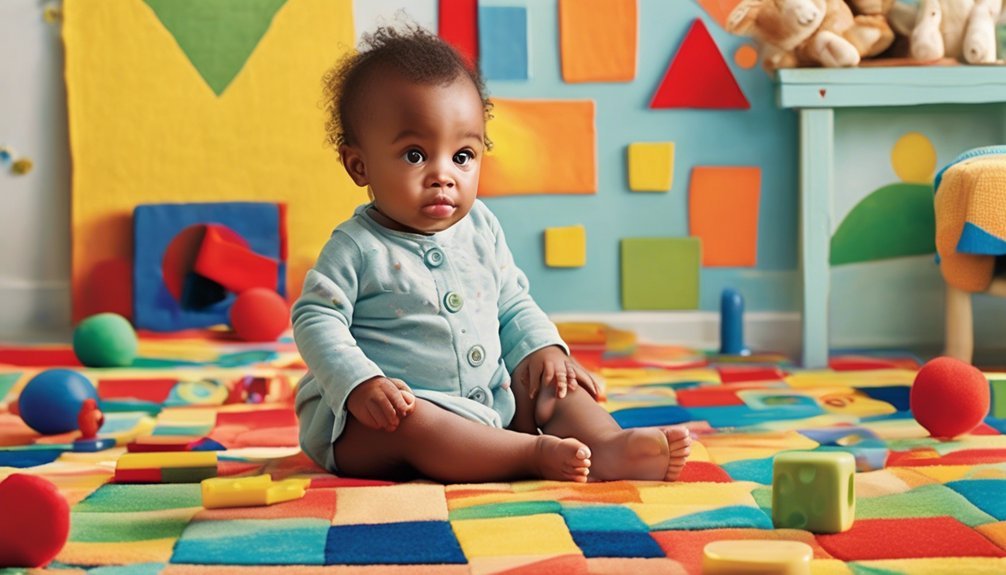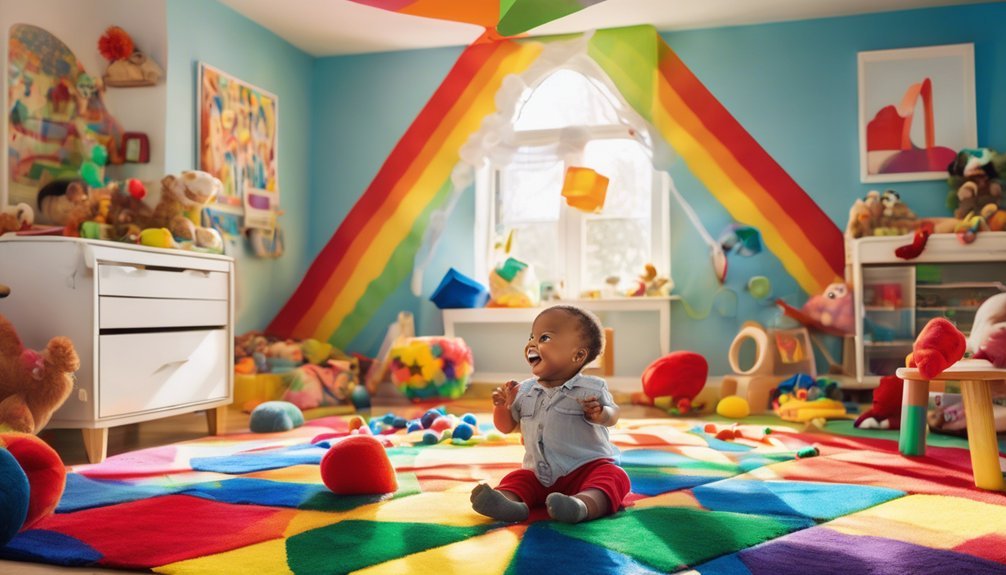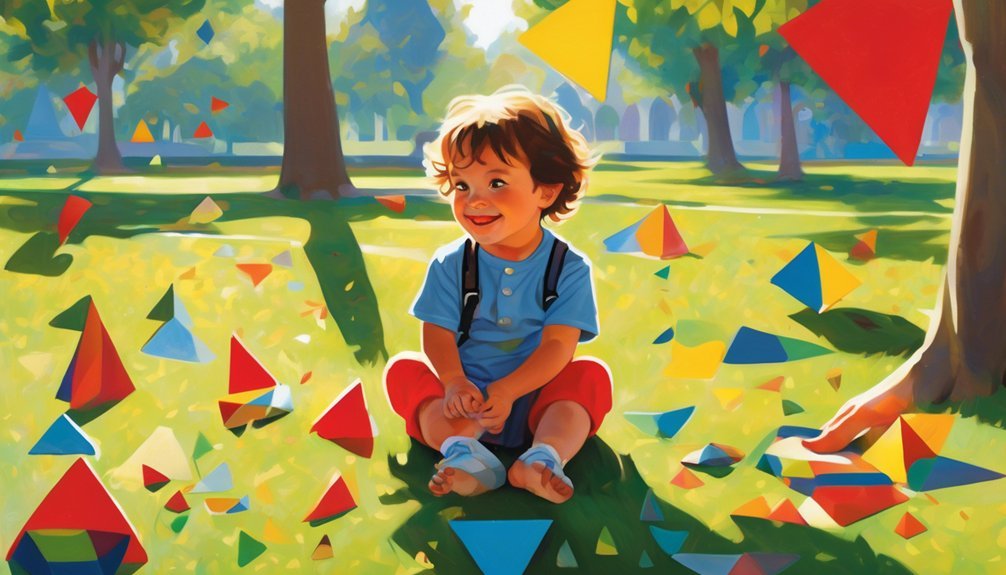Teaching your baby about shapes and colors is more than just fun—it’s a crucial part of their growth. By introducing these concepts early, you’re helping to build their cognitive skills and visual perception. As you embark on this journey, you’ll discover engaging activities that can spark their curiosity. But where do you begin, and what methods work best? Let’s explore the best approaches to make learning shapes and colors both enjoyable and effective.
Key Takeaways
- Start teaching shapes and colors around 18 months when toddlers are eager to learn and explore their environment.
- Use engaging activities like shape sorting and scavenger hunts to reinforce recognition of shapes and colors in everyday objects.
- Incorporate colorful crafts and hands-on experiments to make learning shapes and colors enjoyable and memorable for your baby.
- Encourage curiosity by asking open-ended questions and providing interactive toys that promote exploration of shapes and colors.
- Monitor progress by creating a Shape and Color Chart and celebrate milestones to boost confidence and further interest in learning.
Understanding the Importance of Shapes and Colors in Early Development

Shapes and colors are like the building blocks of your child’s early learning journey. They play a vital role in cognitive development, helping your little one make sense of the world around them.
When you introduce different shapes and colors, you’re not just filling their environment with beauty; you’re enhancing their visual perception, allowing them to distinguish and categorize objects. This early engagement sparks curiosity and lays the groundwork for problem-solving skills and critical thinking.
As your child explores these concepts, they’re also developing language skills by learning to name and describe what they see. So, take the time to point out shapes and colors in everyday life—it’s a simple yet powerful way to nurture their growth and foster a love for learning.
The Best Age to Start Teaching Shapes and Colors
Research shows that introducing your child to shapes and colors as early as 18 months can set the stage for lifelong learning. This is the ideal age to start, as your little one is beginning to explore the world around them.
At this developmental stage, toddlers are naturally curious and eager to absorb new information. They’ll delight in pointing out colorful objects and different shapes, turning everyday moments into learning opportunities.
By engaging them in simple conversations about what they see, you help strengthen their cognitive skills. Remember, every child develops at their own pace, so stay attuned to your child’s unique interests and readiness.
Nurturing their love for shapes and colors now will pave the way for future learning adventures!
Engaging Activities for Shape Recognition
Introducing your little one to shapes can be as fun as it’s educational! To spark their interest, try a shape sorting activity. Gather various household items—think lids, blocks, or even toys—and let your child match them to a corresponding shape chart. This hands-on experience makes learning enjoyable and memorable.
Another engaging option is a shape scavenger hunt. Create a simple list of shapes and encourage your little one to find them around your home or yard. You’ll be amazed at how quickly they start recognizing circles, squares, and triangles in everyday objects!
These interactive activities not only boost shape recognition but also foster a sense of exploration and curiosity. So, dive in and watch your child’s confidence grow!
Fun Ways to Introduce Colors

After exploring shapes, it’s time to turn your attention to colors! Introducing your baby to the vibrant world of colors can be a delightful journey.
Here are some fun ways to make it memorable:
- Colorful Crafts: Gather safe, non-toxic materials and create art together. Let your baby explore different colors with finger paints or colored paper.
- Playful Experiments: Fill clear containers with water and add food coloring. Watch as your baby marvels at how colors mix and change!
- Color Scavenger Hunt: Go on a treasure hunt around the house or yard, searching for items of specific colors. This playful activity sparks curiosity and engagement.
These activities not only teach colors but also create precious bonding moments. Enjoy the colorful adventure!
Using Everyday Objects to Teach Concepts
While you might think formal lessons are the best way to teach your baby, everyday objects can be powerful tools for exploring shapes and colors.
Look around your home—those kitchen utensils can introduce circular shapes, while toy blocks provide a colorful spectrum to play with.
Dress your little one in vibrant everyday clothing and point out the hues together.
When shopping, use grocery items to discuss colors and shapes—bananas are yellow and curved!
Venture outside to discover nature objects like leaves or flowers, and don’t forget to explore your household furniture for rectangles and squares.
Lastly, art supplies can spark creativity, and garden tools can help teach about shapes in a fun, hands-on way.
Interactive Games for Learning Shapes and Colors
Games can turn learning about shapes and colors into an exciting adventure for your little one. Try these interactive activities to spark curiosity and boost their skills:
- Shape Sorting: Gather various shapes and let your child sort them by color or shape. This hands-on activity reinforces recognition and categorization.
- Color Matching: Use colored cards or blocks, and challenge your little one to match colors with similar objects around the house. This helps them connect colors to real-world items.
- Shape Hunt: Go on a treasure hunt around your home or yard, looking for objects that match specific shapes. It’s a fun way to explore while learning!
These interactive games create joyful moments while helping your child grasp important concepts.
Incorporating Music and Movement

Music and movement can transform learning about shapes and colors into a lively experience for your little one. Incorporate fun musical movement activities to engage their senses.
Play rhythm games that encourage them to clap, stomp, or sway to the beat while identifying different shapes and colors. You might sing songs that emphasize colors—like “Red and Yellow, Green and Blue”—and invite your child to dance around the room, mimicking the shapes you see.
Create a colorful dance floor using colored paper shapes, and as they jump from one to another, they’ll be learning without even realizing it. These playful interactions help deepen their understanding and make learning a joyful adventure you both can cherish!
Craft Projects to Reinforce Learning
Craft projects provide a hands-on approach to solidifying your child’s understanding of shapes and colors. Engaging in creative activities not only enhances learning but also deepens your bond.
Here are three fun craft ideas to get started:
- Shape Collages: Gather colorful paper, scissors, and glue. Let your child cut out various shapes and arrange them into a vibrant collage, reinforcing shape recognition.
- Color Mixing Fun: Use washable paints to explore color mixing. Create a palette and encourage your little one to blend primary colors, discovering new shades together.
- Shape Sorting Boxes: Decorate boxes with different shapes and colors. Have your child sort small objects into the corresponding boxes, reinforcing both concepts while having a blast!
Get ready for a joyful crafting adventure!
The Role of Books in Shape and Color Education
While exploring shapes and colors through hands-on activities is essential, books also play a crucial role in your child’s learning journey. Children’s literature, with its vibrant illustrations and engaging stories, invites visual learning, making it easier for your little one to grasp these concepts. As you read together, you can point out different shapes and colors, reinforcing their understanding in a fun way.
Here’s a quick reference to some engaging book types:
| Book Type | Shape Focus | Color Focus |
|---|---|---|
| Board Books | Simple Shapes | Bold Colors |
| Picture Books | Complex Shapes | Soft Colors |
| Interactive Books | 3D Shapes | Pastel Shades |
| Concept Books | Geometric Shapes | Primary Colors |
| Rhyming Books | Everyday Shapes | Rainbow Colors |
These delightful reads create meaningful connections, making learning a joyful experience.
Outdoor Activities to Explore Shapes and Colors

Exploring the great outdoors offers a fantastic opportunity for your child to discover shapes and colors in their natural environment.
You can turn a simple outing into an exciting learning adventure! Here are three fun activities to try:
- Nature Scavenger Hunt: Create a list of items for your child to find, focusing on different shapes like circles (rocks) or triangles (leaves).
- Shape Hunt: As you stroll, encourage your child to point out shapes in signs, trees, and buildings, reinforcing their recognition skills.
- Color Walk: Pick a color of the day and search for items that match, sparking curiosity about the world around them.
Finish off the day with some outdoor art, using natural materials to create colorful masterpieces together!
Tips for Encouraging Curiosity and Creativity
Fostering your child’s curiosity and creativity can transform everyday moments into exciting learning experiences. Encourage exploration by asking open-ended questions that let their imagination run wild. When curiosity sparks, you’re opening doors to new ideas and discoveries.
Use colorful, interactive toys and art supplies to enhance their playtime. Let them mix colors and shapes, and watch how their creativity boosts with every stroke. Create a “wonder wall” at home where they can display their artwork and discoveries. Celebrate their questions and ideas, showing them that every thought matters.
Lastly, take time to explore the world together—visit parks, museums, or even the grocery store. These adventures not only teach shapes and colors but also nurture a lifelong love of learning.
Monitoring Progress and Celebrating Milestones
Monitoring your baby’s progress in learning shapes and colors is essential to their development and confidence. By keeping an eye on their growth, you can make adjustments and celebrate their achievements.
Here are three engaging ways to track progress and celebrate milestones:
- Create a Shape and Color Chart: Document their learning journey with a colorful chart. It’s a fun visual reminder of their progress.
- Set Mini-Milestones: Break down learning into smaller goals. Celebrate when they can identify a new shape or color!
- Host a Celebration Day: Organize a small party with friends or family to showcase your baby’s newfound skills. Share the joy of their learning journey!
With consistent progress tracking and milestone celebrations, you’ll foster a love for learning that lasts a lifetime.
Frequently Asked Questions
What Are the Best Resources for Teaching Shapes and Colors?
When you’re looking to teach shapes and colors, try interactive toys that engage little hands and minds. Educational apps also make learning fun and interactive, helping your child explore and discover in exciting ways.
How Can I Tell if My Baby Is Learning Shapes and Colors?
Did you know babies start recognizing shapes by six months? You’ll notice your baby hitting milestones when they point, sort, or name shapes and colors. Engage with fun learning methods, and watch their excitement grow!
Are There Specific Colors or Shapes That Are Easier to Teach First?
You’ll find that starting with primary colors like red, blue, and yellow, along with basic shapes like circles and squares, makes learning fun and engaging for your little one. They grasp these concepts more easily!
Can Teaching Shapes and Colors Improve My Baby’s Language Skills?
As you paint your baby’s world with vibrant colors and playful shapes, you’re not just having fun; you’re nurturing their language development and cognitive skills, weaving a tapestry of learning that sparks their imagination and curiosity.
How Do Cultural Differences Affect Shape and Color Perception in Babies?
Cultural differences shape how you perceive colors and shapes. You’ll notice that cultural symbolism influences visual recognition, helping your baby learn unique meanings and associations. Embracing these differences enriches their understanding of the world around them.
Conclusion
By weaving shapes and colors into your daily life, you’re planting seeds of curiosity in your child’s mind. Just like a garden needs sunlight and water to thrive, your little one flourishes with your encouragement and playful guidance. Remember the joy of discovering a rainbow after a rainstorm? That’s the excitement you’re nurturing as you explore these concepts together. Celebrate each small victory, and watch as your child’s world bursts into vibrant hues and fascinating forms!




